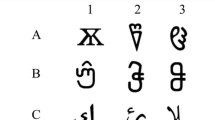Abstract
The present study investigated whether simple discrimination procedures produce emergent relations that are consistent with functional and equivalence classes. In Experiment 1, 4 normally capable adults were exposed to simple successive discrimination reversal training. Responses to the S+ (A1, B1, and C1) but not S− (A2, B2, and C2) were reinforced. The participants were then exposed to repeated-reversal training, followed by tests of emergent equivalence relations. In Experiment 2, 4 additional adults were exposed to a simple successive discrimination training procedure using differential responses. Response 1 (R1) was reinforced only when emitted in the presence of A1, B1, or C1 (A1-R1, B1-R1, or C1-R1). Response 2 (R2) was reinforced only in the presence of A2, B2, or C2 (A2-R2, B2-R2, or C2-R2). A new response was then trained in the presence of 1 member of each class (A1-R3, A2-R4). A transfer-of-function test was then conducted to verify whether the new responses would be emitted in the presence of B1, B2, C1, and C2. In both experiments, emergent conditional relations were tested using a go/no-go procedure with compound stimuli. In Experiment 1, all of the participants showed functional classes, and 3 showed patterns that are consistent with the formation of equivalence classes. In Experiment 2, all 4 participants showed patterns that are consistent with functional and equivalence class formation. In these experiments, simple discrimination training generated a range of emergent stimulus relations that mirrored those that are indicative of equivalence class formation.

Similar content being viewed by others
References
Barnes, D., & Keenan, M. (1993). A transfer of functions through derived arbitrary and nonarbitrary stimulus relations. Journal of the Experimental Analysis of Behavior, 59, 61–81.
Barnes, D., Browne, M., Smeets, P., & Roche, B. (1995). A transfer of functions and a conditional transfer of functions through equivalence relations in three- to six-year-old children. The Psychological Record, 45, 405–430.
Critchfield, T. S. (2014). Online equivalence-based instruction about statistical inference using written explanation instead of match-to-sample. Journal of Applied Behavior Analysis, 47, 606–611.
Debert, P., Matos, M. A., & McIlvane, W. J. (2007). Conditional relations with compound abstract stimuli using a go/no-go procedure. Journal of the Experimental Analysis of Behavior, 87, 89–96.
Debert, P., Huziwara, E. M., Faggiani, R. B., de Mathis, M. E. S., & McIlvane, W. J. (2009). Emergent conditional relations in a go/no-go procedure: Figure-ground and stimulus-position compound relations. Journal of the Experimental Analysis of Behavior, 92, 233–243.
Devany, J. M., Hayes, S. C., & Nelson, R. O. (1986). Equivalence class formation in language-able and language-disabled children. Journal of the Experimental Analysis of Behavior, 46, 243–257.
Frank, A. J., & Wasserman, E. A. (2005). Associative symmetry in the pigeon after successive matching-to-sample training. Journal of the Experimental Analysis of Behavior, 84, 147–165.
Goldiamond, I. (1962). Perception. In A. J. Bachrach (Ed.), Experimental foundations of clinical psychology (pp. 280–340). New York: Basic Books.
Goldiamond, I. (1966). Perception, language and conceptualization rules. In B. Kleinmuntz (Ed.), Problem solving: Research, method and theory (pp. 183–214). New York: Wiley.
Kastak, C. R., Schusterman, R. J., & Kastak, D. (2001). Equivalence classification by California sea lions using class-specific reinforcers. Journal of the Experimental Analysis of Behavior, 76, 131–158.
Lazar, R. (1977). Extending sequence-class membership with matching to sample. Journal of the Experimental Analysis of Behavior, 27, 381–392.
Markham, M. R., & Dougher, M. J. (1993). Compound stimuli in emergent stimulus relations: Extending the scope of stimulus equivalence. Journal of the Experimental Analysis of Behavior, 60, 529–542.
Perez, W. F., Campos, H. C., & Debert, P. (2009). Procedimento go/no-go com estímulos compostos e a emergência de duas classes de equivalência com três estímulos (Go/no-go procedure with compound stimuli and the emergence of two equivalence classes with three stimuli). Acta Comportamentalia, 17, 191–210.
Sidman, M. (1994). Equivalence relations and behavior: A research history. Boston: Authors Cooperative.
Sidman, M. (2000). Equivalence relations and the reinforcement contingency. Journal of the Experimental Analysis of Behavior, 74, 127–146.
Sidman, M., & Tailby, W. (1982). Conditional discrimination vs. matching to sample: An expansion of testing paradigm. Journal of the Experimental Analysis of Behavior, 37, 5–22.
Sidman, M., Wynne, C. K., Maguire, R. W., & Barnes, T. (1989). Functional classes and equivalence relations. Journal of the Experimental Analysis of Behavior, 52, 261–274.
Smeets, P. M., Barnes, D., & Roche, B. (1997). Functional equivalence in children: Derived stimulus–response and stimulus-stimulus relations. Journal of Experimental Child Psychology, 66, 1–17.
Smeets, P. M., Barnes-Holmes, D., & Roche, B. (2001). Derived stimulus–response and stimulus-stimulus relations in children and adults: Assessing training order effects. Journal of Experimental Child Psychology, 78, 130–154.
Stromer, R., McIlvane, W. J., & Serna, R. W. (1993). Complex stimulus control and equivalence. Psychological Record, 43, 585–598.
Sweeney, M. M., & Urcuioli, P. J. (2010). Reflexivity in pigeons. Journal of the Experimental Analysis of Behavior, 94, 267–282.
Urcuioli, P. J. (2008). Associative symmetry, antisymmetry, and a theory of pigeons’ equivalence-class formation. Journal of the Experimental Analysis of Behavior, 90, 257–282.
Urcuioli, P. J. (2011). Emergent identity matching after successive matching training: I. Reflexivity or generalized identity? Journal of the Experimental Analysis of Behavior, 96, 329–341.
Vaughan, W. (1988). Formation of equivalence sets in pigeons. Journal of Experimental Psychology: Animal Behavior Processes, 14, 36–42.
Wulfert, E., & Hayes, S. C. (1988). Transfer of a conditional ordering response through conditional equivalence classes. Journal of the Experimental Analysis of Behavior, 50, 125–144.
Author Note
Daniela S. Canovas and Paula Debert are members of the Instituto Nacional de Ciência e Tecnologia sobre Comportamento, Cognição e Ensino (National Institute of Science and Technology on Behavior, Cognition, and Teaching), supported by FAPESP (2008/57705-8), and Conselho Nacional de Ciência de Tecnologia (CNPq; Brazilian Research Council, 573972/2008-7). Daniela S. Canovas was supported by a FAPESP grant (2010/06422-6).
Author information
Authors and Affiliations
Corresponding authors
Rights and permissions
About this article
Cite this article
de Souza Canovas, D., Debert, P. & Pilgrim, C. Transfer-of-Function and Novel Emergent Relations Using Simple Discrimination Training Procedures. Psychol Rec 65, 337–346 (2015). https://doi.org/10.1007/s40732-014-0109-9
Published:
Issue Date:
DOI: https://doi.org/10.1007/s40732-014-0109-9




